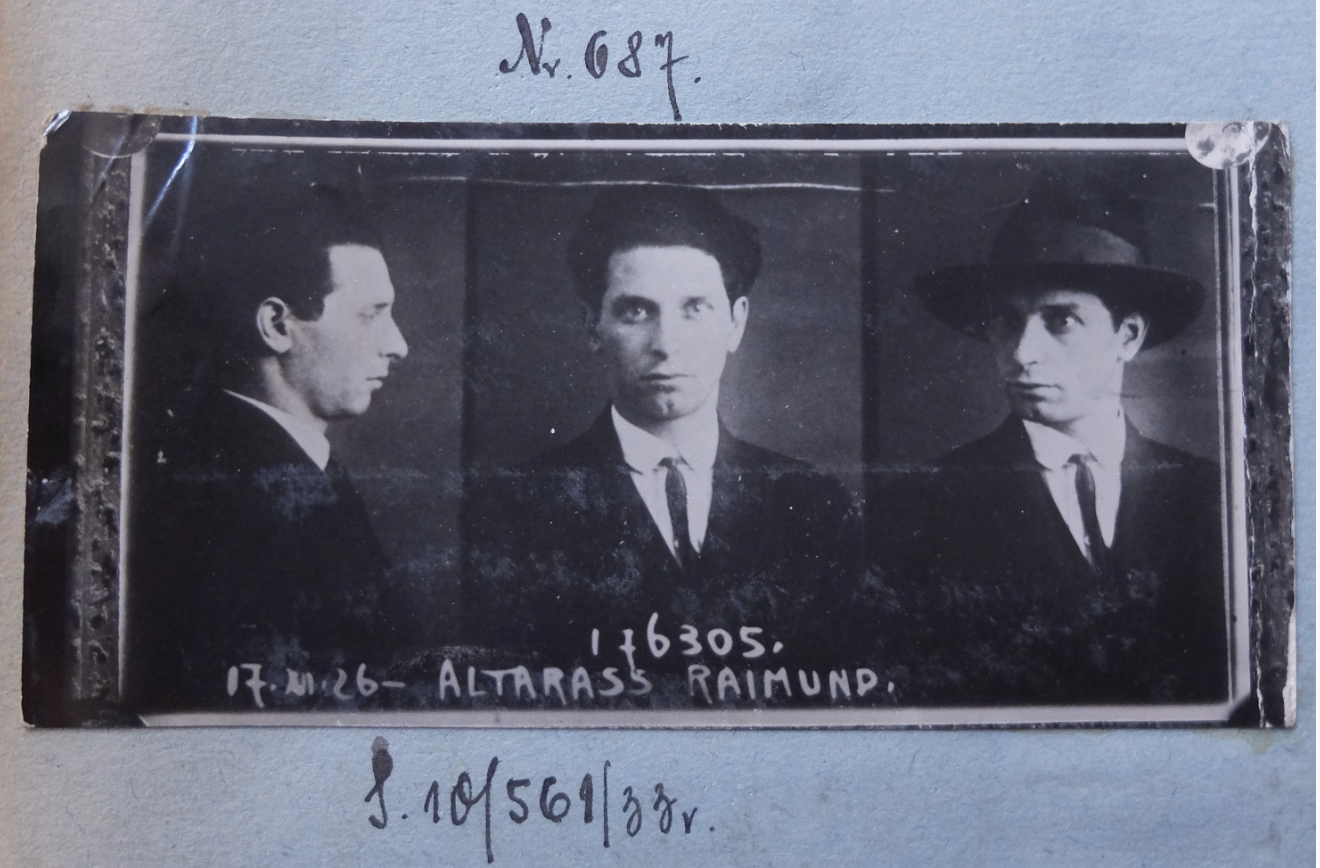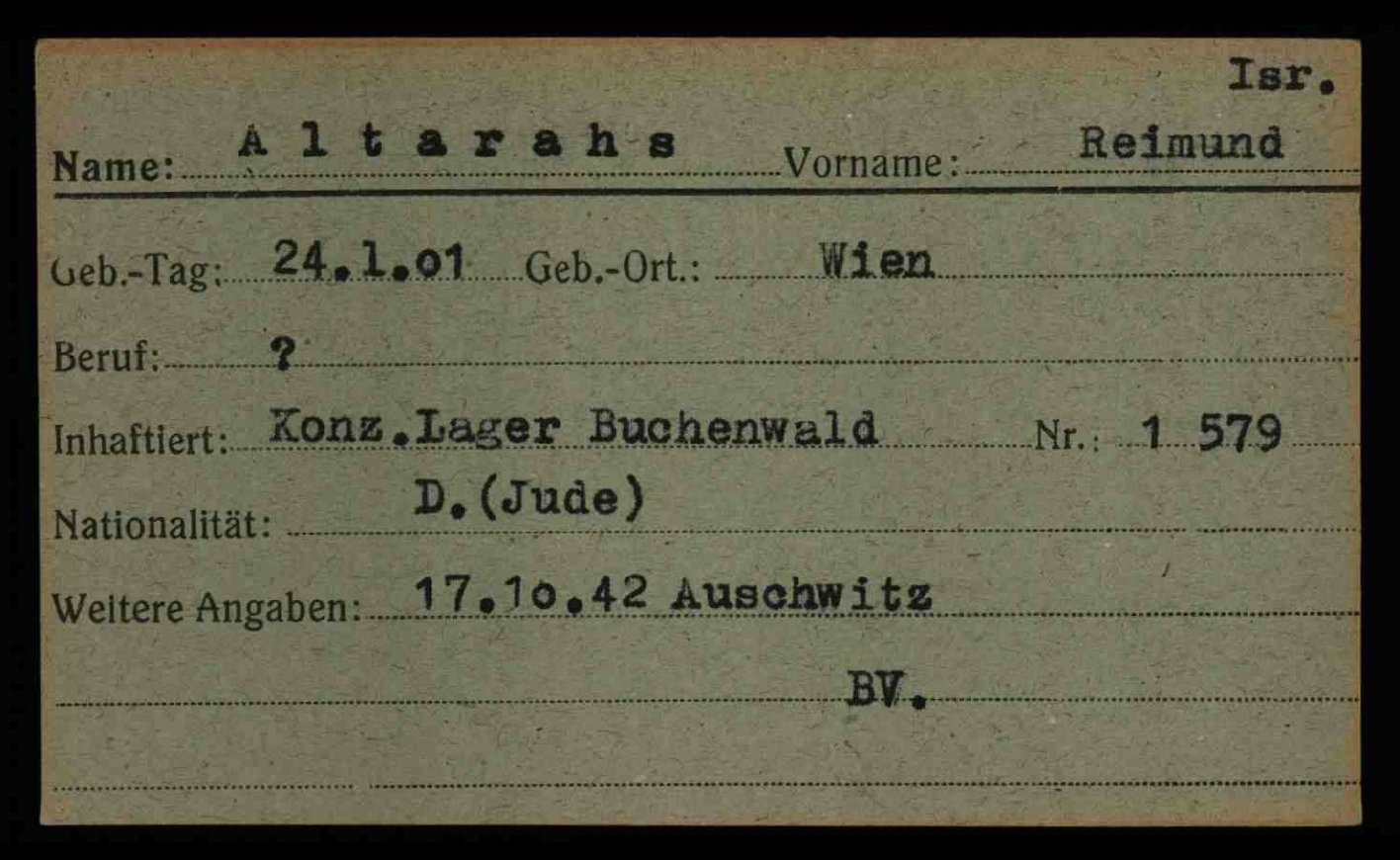Raimund Altaras> August 16, 1938
29b Raimund Altaras
In the House of Truth: Raimund Altaras and his various lives
Hohenems-Diepoldsau, August 16, 1938
On December 2, 1938, the cantonal police in St. Gallen inquires at the Swiss Justice and Police Department in Bern:
"Mr. Head of Department,
among the Jewish emigrants in St. Gallen there is one Altaras Raimund, divorced, salesman, born January 24, 1901 in Vienna, registered there, who is undoubtedly identical to Altaras Raimund, who was announced by your office for fraud in the Swiss Police Gazette, year 1933, under number 12922.
We request your instructions as to what is to be done with this man."[1]
Apparently there is a five-year-old international arrest warrant from Graz police headquarters. Raimund Altaras, who was staying at the historic “Haus zur Wahrheit” on Gallusplatz, was taken into custody.
He crossed the border near Diepoldsau on August 16, 1938. No further details can be found in the surviving documents. In St. Gallen, he declared himself to be a journalist. But like so many other things, as will become clear later, this job description is obviously a deception.
The St. Gallen remand prison is not the first penal institution that Raimund Altaras has seen from the inside. Born in Vienna in 1901 into a Sephardic Jewish family that belonged to the so-called “Turkish community”, he was already forced to look after himself as a child. When he was five years old, his mother died and at the age of ten his father sent him to the Kaiser-Franz-Josef boys' orphanage.
At the age of fourteen, he was already living alone as a subtenant and eventually began working as a salesman in the fur and leather industry. He was soon convicted of embezzling goods. His marriage did not last long either. And in 1928, he and a colleague set up a bogus office for carrying out fraudulent activities, the “Interessenverband Moderne Propaganda”. An exhibition of modern arts and crafts organized by them in a luxury hotel in Baden ended with an attempt to turn the valuable objects into money in pawnshops.
The next prison sentences followed in 1930 and 1933. In the meantime, he went by posturing names such as Leon Bergh and Dr. Erich Jung.
At the beginning of 1939 in St. Gallen, however, his future was still quite uncertain. In January, the St. Gallen police officers learn that the arrest warrant from Graz is no longer valid. After all, the wanted man had actually been arrested in Moravian Ostrava and sentenced at the end of 1933.
Nevertheless, his fate seemed sealed. On April 20, 1939, Raimund Altaras was handed over to the Gestapo in Bregenz by the St. Gallen police and taken to the prison. On July 8, now categorized as a Jew and a professional criminal, he was transferred to Dachau concentration camp.
Several dossiers in the archive of the former International Tracing Service of the Red Cross in Arolsen report on his journey through the camps. [2] The collection of documents was prompted not least by an unusual request from Prison Directorate 1 of the Regional Court for Criminal Matters in Vienna in 1965.
A certain Raimund Altaras, now a pensioner by profession, is to be released from prison for good behavior. The management wanted to know whether the information he had given about his imprisonment in concentration camps was true. In fact, the International Tracing Service of the Red Cross is able to clarify that Raimund Altaras was imprisoned in Dachau as prisoner no. 34548 until September 25, 1939, and then as prisoner no. 1579 in Buchenwald until October 17, 1942, where he was assigned to the punishment detachment, among other things. From there, he was transferred to Auschwitz on October 17 as prisoner no. 68347 in the Monowitz subcamp, which worked for the IG-Farben chemical trust. Finally, from January 18, 1944, he did another year of forced labor in the cement works of the Auschwitz subcamp Golleschau.
The camp was then evacuated. When and where Altaras was liberated after six years of imprisonment and hard labor is also not known from the documents compiled by Arolsen.
However, in 1951 Altaras was back in Vienna. In 1953, he was arrested once again in Graz for attempted marriage fraud under the name Dr. Hörmann and served a prison sentence until 1958. He then lived in Vienna again until 1962 and soon began his next prison sentence there - possibly for the last time - which was to end in 1965. After his release, he was still registered at two addresses in Vienna, then his traces disappear in 1969.
We do not know where Raimund Altaras spent the last years of his life. What he would have had to tell would have been enough for a novel. Even if he was creative with the truth. When he was sent to Buchenwald concentration camp, he claimed to be an architect - and the nephew of the last chairman of the Hohenems Jewish community, Theodor Elkan. [3] Perhaps Elkan, who was known for his kindness and generosity, had helped Altaras cross the border into Switzerland. Perhaps he had only appeared to the homeless impostor as the dream of a perfect family that Raimund Altaras had never known.[4]
[1] Dossier Raimund Altaras, Bundesarchiv Bern: E4264#2004/103#567* ALTARAS RAIMUND; 24.01.1901; BERGH LEON (alias); JUNG ERICH (alias).
[2] Dossiers under the names Raimund Altaras, Reimund Altarahs, Raymond Altarahs and Raimund Altarahs, Arolsen Archives,
[4] More on Raimund Altaras: https://www.hohenemsgenealogie.at/getperson.php?personID=I58103&tree=Hohenems
29b Raimund Altaras
In the House of Truth: Raimund Altaras and his various lives
Hohenems-Diepoldsau, August 16, 1938
On December 2, 1938, the cantonal police in St. Gallen inquires at the Swiss Justice and Police Department in Bern:
"Mr. Head of Department,
among the Jewish emigrants in St. Gallen there is one Altaras Raimund, divorced, salesman, born January 24, 1901 in Vienna, registered there, who is undoubtedly identical to Altaras Raimund, who was announced by your office for fraud in the Swiss Police Gazette, year 1933, under number 12922.
We request your instructions as to what is to be done with this man."[1]
Apparently there is a five-year-old international arrest warrant from Graz police headquarters. Raimund Altaras, who was staying at the historic “Haus zur Wahrheit” on Gallusplatz, was taken into custody.
He crossed the border near Diepoldsau on August 16, 1938. No further details can be found in the surviving documents. In St. Gallen, he declared himself to be a journalist. But like so many other things, as will become clear later, this job description is obviously a deception.
The St. Gallen remand prison is not the first penal institution that Raimund Altaras has seen from the inside. Born in Vienna in 1901 into a Sephardic Jewish family that belonged to the so-called “Turkish community”, he was already forced to look after himself as a child. When he was five years old, his mother died and at the age of ten his father sent him to the Kaiser-Franz-Josef boys' orphanage.
At the age of fourteen, he was already living alone as a subtenant and eventually began working as a salesman in the fur and leather industry. He was soon convicted of embezzling goods. His marriage did not last long either. And in 1928, he and a colleague set up a bogus office for carrying out fraudulent activities, the “Interessenverband Moderne Propaganda”. An exhibition of modern arts and crafts organized by them in a luxury hotel in Baden ended with an attempt to turn the valuable objects into money in pawnshops.
The next prison sentences followed in 1930 and 1933. In the meantime, he went by posturing names such as Leon Bergh and Dr. Erich Jung.
At the beginning of 1939 in St. Gallen, however, his future was still quite uncertain. In January, the St. Gallen police officers learn that the arrest warrant from Graz is no longer valid. After all, the wanted man had actually been arrested in Moravian Ostrava and sentenced at the end of 1933.
Nevertheless, his fate seemed sealed. On April 20, 1939, Raimund Altaras was handed over to the Gestapo in Bregenz by the St. Gallen police and taken to the prison. On July 8, now categorized as a Jew and a professional criminal, he was transferred to Dachau concentration camp.
Several dossiers in the archive of the former International Tracing Service of the Red Cross in Arolsen report on his journey through the camps. [2] The collection of documents was prompted not least by an unusual request from Prison Directorate 1 of the Regional Court for Criminal Matters in Vienna in 1965.
A certain Raimund Altaras, now a pensioner by profession, is to be released from prison for good behavior. The management wanted to know whether the information he had given about his imprisonment in concentration camps was true. In fact, the International Tracing Service of the Red Cross is able to clarify that Raimund Altaras was imprisoned in Dachau as prisoner no. 34548 until September 25, 1939, and then as prisoner no. 1579 in Buchenwald until October 17, 1942, where he was assigned to the punishment detachment, among other things. From there, he was transferred to Auschwitz on October 17 as prisoner no. 68347 in the Monowitz subcamp, which worked for the IG-Farben chemical trust. Finally, from January 18, 1944, he did another year of forced labor in the cement works of the Auschwitz subcamp Golleschau.
The camp was then evacuated. When and where Altaras was liberated after six years of imprisonment and hard labor is also not known from the documents compiled by Arolsen.
However, in 1951 Altaras was back in Vienna. In 1953, he was arrested once again in Graz for attempted marriage fraud under the name Dr. Hörmann and served a prison sentence until 1958. He then lived in Vienna again until 1962 and soon began his next prison sentence there - possibly for the last time - which was to end in 1965. After his release, he was still registered at two addresses in Vienna, then his traces disappear in 1969.
We do not know where Raimund Altaras spent the last years of his life. What he would have had to tell would have been enough for a novel. Even if he was creative with the truth. When he was sent to Buchenwald concentration camp, he claimed to be an architect - and the nephew of the last chairman of the Hohenems Jewish community, Theodor Elkan. [3] Perhaps Elkan, who was known for his kindness and generosity, had helped Altaras cross the border into Switzerland. Perhaps he had only appeared to the homeless impostor as the dream of a perfect family that Raimund Altaras had never known.[4]
[1] Dossier Raimund Altaras, Bundesarchiv Bern: E4264#2004/103#567* ALTARAS RAIMUND; 24.01.1901; BERGH LEON (alias); JUNG ERICH (alias).
[2] Dossiers under the names Raimund Altaras, Reimund Altarahs, Raymond Altarahs and Raimund Altarahs, Arolsen Archives,
[4] More on Raimund Altaras: https://www.hohenemsgenealogie.at/getperson.php?personID=I58103&tree=Hohenems



